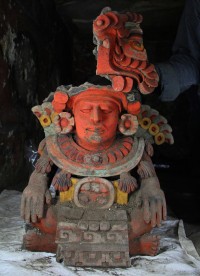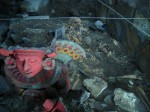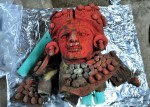 The Zapotec anthropomorphic clay pot that was discovered in the third chamber of the vertical tomb in the Atzompa Archaeological Zone in Oaxaca last August has now been fully excavated and may prove to be a vital clue to the identity of the nobleman buried in the chamber. It’s also incredibly beautiful. In addition to the brilliant red pigment on the face which was immediately visible when it was first discovered, rich ochre and grayish green pigments remain intact on other parts of the vessel.
The Zapotec anthropomorphic clay pot that was discovered in the third chamber of the vertical tomb in the Atzompa Archaeological Zone in Oaxaca last August has now been fully excavated and may prove to be a vital clue to the identity of the nobleman buried in the chamber. It’s also incredibly beautiful. In addition to the brilliant red pigment on the face which was immediately visible when it was first discovered, rich ochre and grayish green pigments remain intact on other parts of the vessel.
According to Mexico’s National Institute of Anthropology and History (INAH), the ceramic pot is about 1200 years old (the three tombs collectively date to 650 – 850 A.D.) and may be an effigy of the person buried in the tomb. The skeletal remains of an adult male and of a teenager, probably female, were discovered in the chamber. The male burial was covered in the same red pigment that dominates the anthropomorphic vessel. That’s why archaeologists think the figure may be a specific representation of the interred male.
 The location of the tomb right next to the House of the Altars — real estate so valuable that Chamber Three was closed up and two more chambers built above it for later big shots — and the quality of grave goods indicate that the resident was someone of high status in Atzompa society. The effigy’s elaborate clothing and decoration may therefore have been duplicating the finery of the man it was buried with.
The location of the tomb right next to the House of the Altars — real estate so valuable that Chamber Three was closed up and two more chambers built above it for later big shots — and the quality of grave goods indicate that the resident was someone of high status in Atzompa society. The effigy’s elaborate clothing and decoration may therefore have been duplicating the finery of the man it was buried with.
 The character on the pot is wearing large inlaid, flower-shaped earrings, a wide semi-circular necklace with tassels hanging off the border, a feather cloak and an elaborate headdress. The headdress is more than 13 inches tall and depicts a feathered reptile with its jaws agape. The Feathered Serpent was an important deity in many Mesoamerican civilizations, including the Zapotecs. As one of the most powerful figures in the pantheon, and any person who donned its symbols would have held considerable political power in the society.
The character on the pot is wearing large inlaid, flower-shaped earrings, a wide semi-circular necklace with tassels hanging off the border, a feather cloak and an elaborate headdress. The headdress is more than 13 inches tall and depicts a feathered reptile with its jaws agape. The Feathered Serpent was an important deity in many Mesoamerican civilizations, including the Zapotecs. As one of the most powerful figures in the pantheon, and any person who donned its symbols would have held considerable political power in the society.
The effigy is also wearing a sash or girdle on which are displayed the iconography and glyphs that identify one person, presumably the male skeleton. One of the glyphs translates to “Tremor” or “Quake” and another is the numeral eight. Archaeologists think the two combined are his name: Tremor Eight. Sounds like a sequel to a Kevin Bacon movie. There are also several repeating Greek key-style shapes and the upside-down symbol of a hill.
 A second clay vessel was also discovered in the chamber. It’s a smaller female figure, probably representing a goddess. It too is brightly painted in red and has fancy accessories like a headpiece and necklace. Both vases have been tested in the attempt to determine how the pigments were made.
A second clay vessel was also discovered in the chamber. It’s a smaller female figure, probably representing a goddess. It too is brightly painted in red and has fancy accessories like a headpiece and necklace. Both vases have been tested in the attempt to determine how the pigments were made.
INAH archaeologists are in the process of radiocarbon dating the artifacts and remains in the tomb to pin down the construction and burial dates. They’ve also taken collagen samples from the skeletons for chemical analysis which might provide us with information about their diets, lifestyles and deaths.